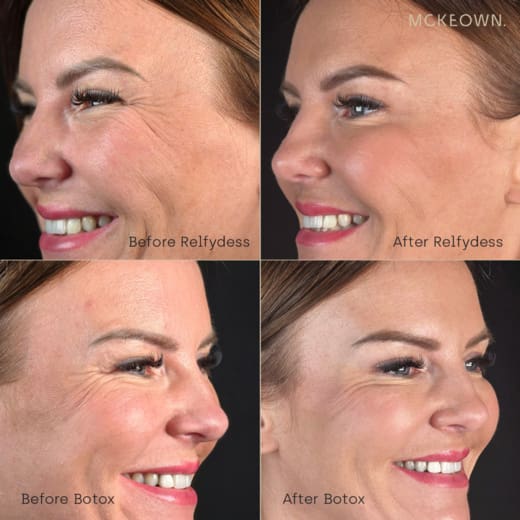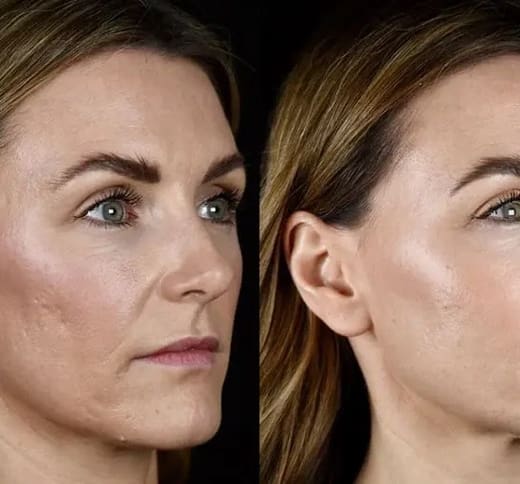McKeown Medical
167 Bath Street, Glasgow, G2 4SQ
Date posted — 12.06.24
Facelifts are often considered the gold standard in facial rejuvenation, yet the term encompasses a variety of procedures, each with distinct outcomes and implications. A surgical facelift typically focuses on the lower face and neck, aiming to remove loose skin and reposition facial tissues for a refreshed appearance.
Volumetric, full, and non-surgical facelifts, as well as lower face and neck lifts, are all part of the options, each addressing specific targets of the face. It’s essential to understand these variations to choose a treatment that aligns with your aesthetic goals, recognising that facelifts often target certain areas rather than the full face and may be combined with other procedures to achieve comprehensive facial rejuvenation.
Facial ageing is characterised by skin laxity, loss of collagen, and reduced facial fat, leading to wrinkles, sagging, and changes in facial contours. This natural process can be accelerated by lifestyle factors such as sun exposure and smoking. As the skin becomes lax and the facial structure alters as a result of bone resorption, the ageing signs become more pronounced, particularly in the face and neck.
Facelifts have evolved significantly, offering a range of options tailored to individual needs and aesthetic goals. Understanding these variations is crucial for selecting the most suitable procedure.
These non-surgical treatments focus on restoring lost facial volume, often using dermal fillers. They are ideal for those seeking subtle improvements without undergoing surgery.
Find out more about Volumetric Facelifts.
As the most comprehensive option, full facelifts address sagging skin and deep folds around the lower half of the face and neck. This surgical procedure involves repositioning underlying tissues and removing excess skin to achieve a more youthful contour.
Find out more about Full Facelifts.
These procedures use advanced technologies, like ultrasound or radio frequency, to tighten skin and stimulate collagen production. They are best suited for patients with mild to moderate skin laxity.
Find out more about Non-Surgical Facelifts.
Specifically targeting the jawline and neck, this surgery combats sagging in these areas, resulting in a more defined jawline and smoother neck.
Each type of facelift offers unique benefits and addresses different concerns, making it essential to discuss options with a qualified surgeon to determine the best approach for your facial rejuvenation.
Ideal for those who show early signs of ageing, a mini facelift is less invasive than a full facelift. This procedure typically focuses on the lower face, addressing areas like the jawline and the upper neck. It involves smaller incisions and a shorter recovery time, making it a popular choice for younger patients or those seeking less dramatic changes.
A deep plane facelift goes deeper than the traditional facelift, targeting the layers beneath the SMAS (superficial musculo-aponeurotic system). This technique allows for more significant lifting and repositioning of facial tissues, leading to more natural-looking results, especially in the midface and neck regions. It is often recommended for patients with more pronounced ageing signs who require comprehensive rejuvenation.
As well as the procedures we have gone through above, see some further additional facelift surgery variations:
The Vampire Facelift is a non-surgical cosmetic procedure that combines the use of hyaluronic acid dermal fillers with platelet-rich plasma (PRP) derived from the patient’s own blood. The process involves injecting the PRP into specific areas of the face, stimulating collagen production and cell turnover. This procedure is designed to restore facial volume, improve skin texture, and result in a rejuvenated, natural appearance. It’s particularly favoured for its organic approach and minimal downtime.
The One Stitch Facelift, as the name suggests, is a minimally invasive procedure that involves a single stitch or suture on each side of the face. It’s designed for those seeking a subtle lift to counter early signs of ageing, particularly around the jawline and neck. The procedure typically involves a local anaesthetic and is known for its quick recovery time. Although the results are more modest compared to more extensive facelift surgeries, it’s an attractive option for individuals looking for immediate improvements with minimal intervention.
The journey towards a rejuvenated appearance begins well before the surgery. During the initial consultation, your surgeon will evaluate your facial structure and skin quality and discuss your aesthetic goals. This conversation ensures that both you and your surgeon are aligned in expectations for the outcome.
On the day of the surgery, the procedure typically involves:
Anaesthesia is administered to ensure comfort and safety during the facelift surgery. Most of our surgical procedures are performed under local anaesthetic, which helps to reduce some of the risks associated with surgery. This means you are free to go home immediately after your treatment, although you will need to be accompanied by a responsible adult for the first 24 hours after your surgery
.
Strategic incisions are made, usually around the hairline and ears, to minimise visible scarring. The specific pattern of incisions will depend on the areas being targeted and the degree of change you’re looking for. These incisions allow the surgeon to access the underlying facial tissues.
Once the incisions are made, the surgeon will proceed to lift and tighten the underlying tissue. This step is crucial in addressing loose skin and reducing the appearance of excess fat. The surgeon carefully reshapes the deeper layers of the face, enhancing the bone structure and contour. During this process, great care is taken to avoid nerve injury, ensuring the facial muscles function properly post-surgery.
After the lifting and tightening are completed, the facial skin is re-draped, and any excess skin is removed. The incisions are then meticulously closed with sutures. This step is crucial for minimising scarring and ensuring a natural-looking result. The incisions are typically closed in a way that follows the natural contours of your face, further enhancing the procedure’s aesthetic outcome.
1. Youthful Appearance
2. Improved Confidence
3. Long-lasting Results
4. Reduction In Excess Skin
5. Reduction Of Deep Wrinkles
Recovery from a facelift is a critical phase. The initial recovery period typically spans 2 to 4 weeks, during which patients may experience swelling, bruising, and discomfort. Key guidelines for a smooth recovery include:
Most patients can return to work and normal activities within a few weeks, but it may take several months to see the full results of the surgery.
Like any surgical procedure, facelift surgery carries certain risks and potential complications. Patients may face risks such as infections, bleeding, or adverse reactions to anaesthesia. Specific to facelifts, there is a possibility of nerve injury, which can affect facial muscle movement or sensation. Scarring, although typically well-hidden, can vary in severity. Asymmetry in facial features and dissatisfaction with the aesthetic outcome are other potential risks. We will discuss these risks in depth to help you make an informed decision and understand the measures to mitigate them.
Facelift surgery is not the only option for facial rejuvenation. There are several non-surgical alternatives and complementary procedures that can enhance or, in some cases, substitute for a facelift:
The results of a facelift can significantly rejuvenate your appearance, but it’s important to have realistic expectations about longevity. Typically, a facelift can last about 10 years, but this varies depending on individual factors like skin quality, lifestyle, and genetics. Ageing continues, so the effects of the facelift will gradually diminish over time. To maintain the results as long as possible:
Facelifts encompass a range of surgical and non-surgical options. Choosing the right procedure for you, whether it’s a full, deep plane, Vampire, or One Stitch Facelift, depends on individual ageing concerns and aesthetic goals. The process involves a detailed consultation, careful planning and understanding of each option. Post-operative care and recovery are crucial for achieving the best results, and maintaining these through a healthy lifestyle and skincare routine is essential. If you’re interested and wish to book a free, no-obligation consultation, our team of cosmetic surgeons in Glasgow are ready to help you with any questions or concerns relating to facelifts or any other treatments.
Medical Director
Our founder, Dr Darren McKeown, is renowned for his expertise and artistry with dermal fillers. As a peer-reviewed medical author, he is passionate about treatments that stand up to scientific scrutiny. Above all, Dr McKeown believes in a global approach, delivering flawless results and lasting rejuvenation.
Consultant Plastic Surgeon
Dr Russell Bramhall is regarded for his facelifts and blepharoplasties, and our specialist plastic surgeon strives for an elegant, “invisible” result. His surgeries are complemented by the work of our non-surgical specialists for a wholly holistic rejuvenation.
Medical Director
Dr Rhona Cameron is a skilled injector who has been extensively trained in Dr McKeown’s signature intuitive technique. Her treatments blend advanced facial optimisation with powerful, energy-based devices – such as lasers, BBL and radio frequency – energising the appearance and enhancing skin health.
Choosing McKeown Medical for a facelift offers a range of expertly tailored treatments designed to rejuvenate and restore a youthful appearance with a focus on natural results. Dr McKeown’s approach to facelifts is informed by a deep understanding of facial anatomy and the ageing process, ensuring treatments that are both effective and harmonious with each individual’s unique features.
Let’s answer some of your frequently asked questions about facelifts.
A few weeks leading up to your facelift surgery is a good time to start ensuring your body is as healthy as possible. The best way to do so is to eat healthily, eat balanced, limit your alcohol intake, and drink plenty of water.
Typically, patients in their mid-40s to early 50s are most likely looking to get a facelift. However, the right time depends more on the individual’s skin condition and ageing signs, not just age alone. Consulting with our qualified surgeons can help you determine the ideal timing based on your needs.
Ten years after a facelift, you can still expect to see noticeable improvements in your facial appearance compared to if you hadn’t undergone the surgery. However, it’s important to remember that a facelift doesn’t halt the ageing process. Factors like skin care, lifestyle, and genetics can influence the longevity of results.
The best facelift procedure depends on individual concerns and desired outcomes. Surgical options like full and deep plane facelifts offer more comprehensive results for pronounced ageing signs. Procedures like the Vampire Facelift or One Stitch Facelift might be suitable for less invasive treatment. Discussing with a surgeon can help identify the most appropriate method for you.

When a new wrinkle-relaxing treatment comes to market, it often generates a lot of buzz but at McKeown Medical, we...

Think varicose vein treatment is painful, risky, or ineffective? Discover the truth as we debunk 5 common myths and reveal...

Struggling with acne scars? We compare microneedling and laser resurfacing to reveal which treatment smooths skin, boosts collagen, and reduces...
1 / 3
2 / 3
3 / 3

When a new wrinkle-relaxing treatment comes to market, it often generates a lot of buzz but at McKeown Medical, we...

Think varicose vein treatment is painful, risky, or ineffective? Discover the truth as we debunk 5 common myths and reveal...

Struggling with acne scars? We compare microneedling and laser resurfacing to reveal which treatment smooths skin, boosts collagen, and reduces...